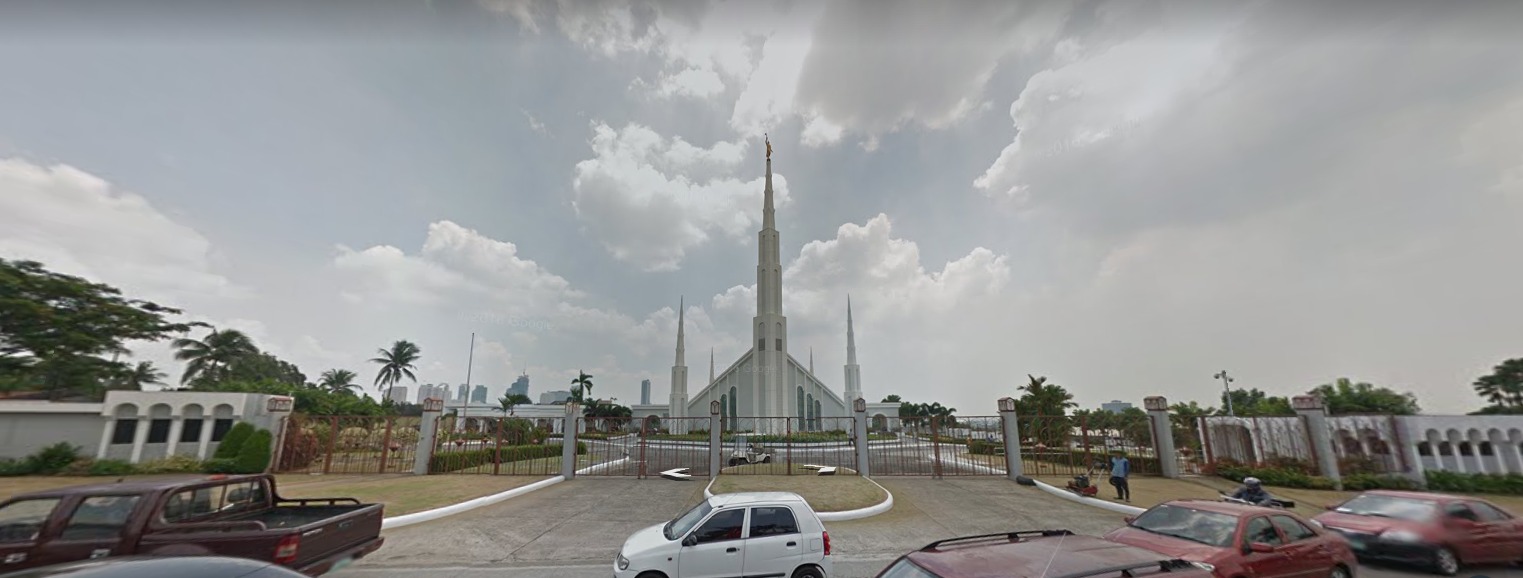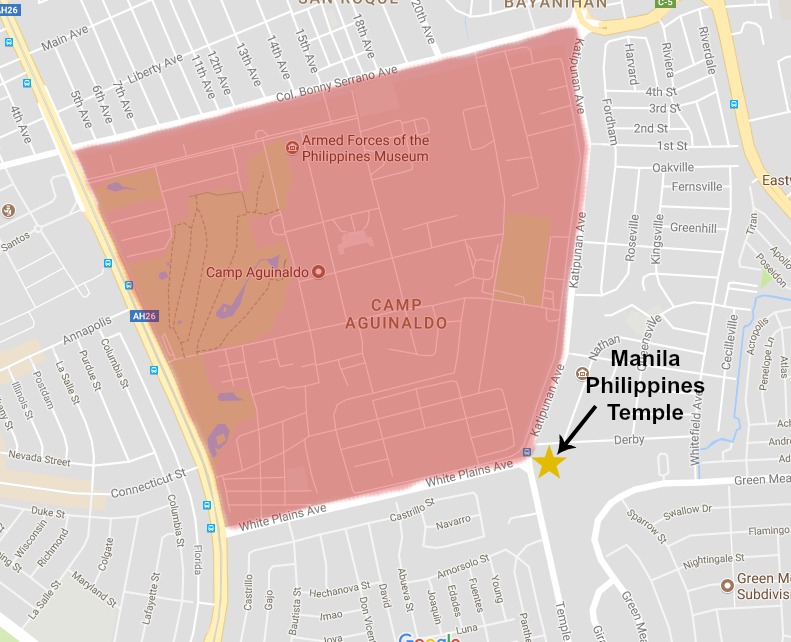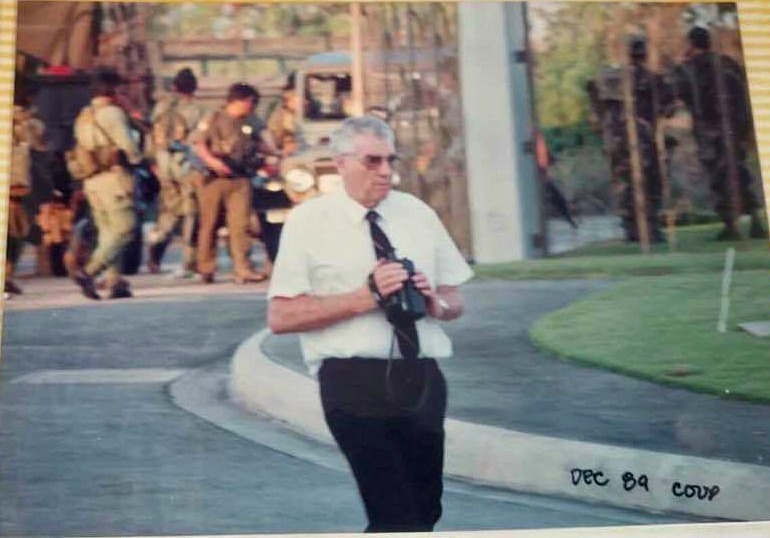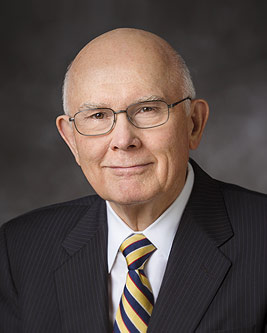Bombs, Bullets and Rockets; How the Manila Temple Miraculously Survived Rebel Occupation
I’ve just stumbled across a juicy bit of history that, frankly, I thought was pretty incredible. It involves guns, mortars, rockets, helicopter gunships, rebel outposts, and the Manila Temple. Oooh yeah, this is my kind of story.
First of all, the Manila Temple has been through some rough stuff

A typhoon threatened Manila the day before the official groundbreaking on the Manila Temple grounds. During a missionary conference that evening, a missionary prayed for the storm to abate, allowing the groundbreaking to continue as planned. The typhoon changed course and the ceremony went as planned on August 25th, 1982, presided over by President Hinckley.
As the dedication neared, mother nature decided to make things difficult again. Just days prior the Philippines experienced two typhoons and an earthquake. Oh, and Mt. Mayon (that’s a volcano) exploded. Sheesh. Luckily (probably not luck) the temple was unaffected as the dedication ceremonies went on as planned in September 1984.
And then this happened:
Attempted Philippine military coup of 1989
In early December 1989, a rebel force attempted to overthrow Philippine President Corazon Aquino. The rebels, mostly consisting of members of the nation’s army and marine corps, were eventually pushed back by government forces.
In May 2000, Elder Dallin H. Oaks gave an incredible Church Education System fireside to members in Calgary, Alberta, Canada, about the coup. The talk is titled Miracles.
“During the first day of the attempted coup, gunfire and bombing could be heard from our temple. That night the road in front of the temple was occupied by rebel armoured vehicles, trucks, and many soldiers. With the coming of daylight on Saturday, these rebel forces exchanged gunfire with the loyal government troops in Camp Aguinaldo. Opposing aircraft fired rockets and dropped bombs,” he said.

By the following afternoon, rebel troops had overcome the temple gate and occupied temple grounds. The two custodians and three security guards were told to let the rebels occupy the grounds and temple annex. Elder Oaks says that one man “worked to develop a good relationship with the rebel soldiers” in an attempt to discourage them from trying to enter the sacred areas of the temple.
And then the shooting started
Elder Oaks continued his account, “Saturday afternoon and Sunday morning there were almost continuous exchanges of gunfire between the government troops in Camp Aguinaldo and the rebels around the camp, including those occupying our temple grounds.” Members fasted and prayed that the temple would not be destroyed in the chaos.
“Sunday morning a government helicopter gunship appeared and strafed the vicinity of the temple, but retreated because of stiff resistance from the rebels’ 50-calibre machine guns. About noon that day an air force plane dropped several bombs that hit the residence house near the temple. Bomb fragments broke windows in the temple annex,” Elder Oaks said.

The situation went from bad to worse when Manila radio reported that government forces were mounting an attack against the rebels occupying “the Mormon temple.” That’s when the temple president, Floyd Hogan, left his home and walked to the massing government forces.
“There he found that their commander had given the rebels one hour to surrender and planned to attack them at 11:00 P.M. His force included armoured personnel carriers, heavy mortars, and at least 150 soldiers, who believed they outnumbered and could easily defeat the rebel force in the temple annex.”
President Hogan, a retired U.S. military man himself, tried to convince the commander to wait to attack until the following morning. He hoped a delay would allow the rebels time to vacate the temple grounds. Unfortunately, a battle plan change such as the one President Hogan proposed could only be issued by the general, whom he was unable to contact.
Meanwhile in Salt Lake City

This is where the miracles start. Elder Oaks continued, “During this time I was the member of the Quorum of the Twelve whom the Philippines Area President contacted for help at headquarters. Thirty minutes before the 11:00 P.M. Manila deadline, Area President George I. Cannon phoned me to report that our temple annex and grounds were the last remaining rebel stronghold in Manila and the army had massed artillery and troops for an assault at any moment. He said he had done all he could through the Philippine government and the American ambassador to discourage the attack, but without success. It was then 7:30 A.M. Sunday in Salt Lake City.
“By a remarkable coincidence—one of those happenings that cannot be coincidental—the First Presidency and Quorum of the Twelve Apostles had scheduled an unusual meeting that Sunday morning. At 8:00 A.M., 3 December, just 30 minutes after I received that alarming report from Manila, the assembled First Presidency and Quorum of the Twelve bowed in prayer and pleaded with the Lord to intervene to protect His house. . . . As we prayed, it was 11:00 P.M. Sunday evening in Manila, the exact hour appointed for the assault.
The miracle
“The attack never came. Twenty minutes after our prayer, President Cannon phoned Church headquarters to report that the military commander had unexpectedly decided against a night assault. Early the next morning, Philippine time, President Hogan phoned to say that the rebels had melted away during the night. I recorded in my journal, ‘I consider this a miracle of divine intervention no less impressive than many recorded in holy writ.'”
(Photos via a temple history album housed at the temple. Photos cropped and edited for color, sharpness and clarity.)
President Hogan was able to survey the damage on Monday morning. The annex had “shrapnel marks and many broken windows on the north side” but rebels did not enter any of the locked rooms within. Nor had they entered the temple proper.
“A total of six mortar or rocket shells had exploded inside the temple grounds,” Elder Oaks said. President Hogan reasoned that, from the looks of things, government forces had to have sent the projectiles between the temple spires. A housing building for temple patrons was under construction nearby, but had been heavily damaged by multiple rocket impacts.
“The Manila temple opened for normal sessions the next day,” Elder Oaks said.
The aftermath
About a week after the attempted coup, Elder Oaks received a letter from the Philippine ambassador to the United States. The letter described how the ambassador had done everything within his power to discourage government forces from damaging the temple.
Elder Oaks said, “After the fighting was over, they had reported to him that ‘they were careful in their counter-shelling, so as not to cause damage’ to the temple. I concluded that the Lord had worked behind the scenes through these government servants to save His house.”
The apostle was later able to inspect the temple in person. The temple itself was spotless, except what appeared to be one stray rifle round that left a small hole at the top of the highest temple spire.
Special thanks to Brooke Porter and Eunice Mate Cangas for the incredible photos.


